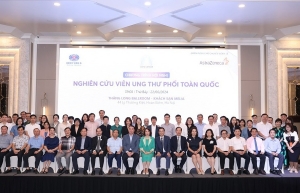Vietnam is pivotal in healthcare potential
What are the overarching trends currently in innovation as well as and research and development in healthcare, both here and beyond?
The past decade has seen large, rapid growth in technologies for discovering and producing new medicines, primarily using new biotechnological techniques. In addition, the structure of the industry has changed, led by the US, with the emergence of thousands of small biotechnology startups, often financed by venture capital, whose focus is the development of new biotech drugs.
 |
| Bui Thi Viet Lam, country representative of the US-ASEAN Business Council |
This segment of the industry has become so important that by 2021, nearly 70 per cent of all new innovative products approved by the US Food and Drug Administration were launched by small companies.
The leaders in the advance of these new technologies have traditionally been the US, which represents about half of the innovative global pharmaceutical industry, and Western Europe. But in more recent years, Asian countries such as Japan, South Korea, and China have invested much in developing their innovative and global pharma sectors.
In recent years, technology has continued to advance in new areas, such as gene and cell therapies, and gene editing, which now account for a growing segment of the new drug pipeline globally. New IT technologies and the use of AI and big data are being used to identify and develop new potential medicines. These are the highest potential growth areas, especially for entrants to the market like Vietnam.
With recent developments, what is the level of interest among your member companies in health innovation in Vietnam?
The Vietnamese pharmaceutical market is currently expanding quickly, and it is likely to grow at more than 10 per cent per annum going forward. This, combined with rising personal incomes, makes Vietnam an attractive destination for global pharmaceutical companies looking to capitalise on emerging market growth potential.
As an emerging market, Vietnam has a unique opportunity to build a sustainable local pharmaceutical industry through the support of global pharmaceutical companies, which are also active members of the US-ASEAN Business Council. With rigorous experience in innovative pharmaceuticals, we are willing to work closely with Vietnam’s policymakers and other stakeholders to facilitate the development of Vietnam’s pharmaceutical industry as a potential key sector in the future growth of the economy and wellbeing of its citizens.
In recent years, our member companies have been setting up local drug manufacturing capabilities or partnering with local manufacturers, which helps drive technology transfer, process research, and capability enhancement of domestic manufacturers. International standards and best practices will also come through the partnership.
To open wider space for improvement in this area, what factors should the sector focus on?
There are several key lessons that can be drawn from the experiences of other countries in the region. Policies that protect local companies from global competition, or provide an unlevel playing field in domestic markets, result in pharmaceutical sectors that are inwardly focused and non-competitive in global markets.
Uncoordinated policies among government agencies affecting the sector have the effect of sending mixed or negative signals to potential investors, and positive policies (such as tax incentives) are easily offset by other policies (such as pricing and regulatory policies).
Built on these lessons, there are some specific recommendations. There could be review and reform of the pricing and reimbursement system in order to provide effective market incentives for local innovation and openness to foreign markets, and to make Vietnamese companies more attractive partners to share technology.
Without such reforms, policies such as tying market access by foreign companies to mandated technology transfer will not be effective.
Creating a more predictable, favourable environment for foreign investment in the pharmaceutical sector is critical. Foreign investors are looking for places to invest in clinical trials as well as manufacturing. The biopharma business model is focused on the mid-to-long term, so a predictable and stable investment environment is vital.
Issues that need to be considered include whether investors in Vietnam’s pharma sector need to already have a viable business in the country, since there is so much potential from investors who have not yet established anything in Vietnam. In addition, tying projects to requirements such as technology transfer or contract manufacturing works to discourage interest in Vietnam.
Manufacturing incentives that are not conditioned in advance on commitment to technology transfer or other business operation requirements are more also likely to engage investor interest and lead to faster decisions. In addition, enabling administrative decisions on imports and exports, licences, and marketing authorisation would act as incentives to manufacturing and are necessary for efficient and competitive manufacturing operations.
Finally, the formation of a high-level inter-ministerial body to coordinate its pharmaceutical industrial policy is needed to ensure that policies are consistent, non-overlapping, and executed efficiently.
 | VIR conference highlights innovation in Vietnam's healthcare sector A conference organised by Vietnam Investment Review (VIR) themed "Empowering Innovation for Vietnam's Sustainable Healthcare" was held on September 25, offering an opportunity for policymakers and companies to discuss innovation in Vietnam's healthcare sector. |
 | Unlocking the potential of healthcare innovations While health innovation in Vietnam is taking place strongly, many challenges prevent the sector from unlocking its full potential. Do Xuan Tuyen, Deputy Minister of Health, talked to VIR’s Minh Tung about global lessons to improve the situation. |
 | Foreign-led groups seize the initiative in healthcare Vietnam’s healthcare sector is rapidly developing as the country seeks to modernise its system and improve health outcomes for its population. Contributing to this transformation are foreign-invested enterprises (FIEs), which have become key players in driving healthcare innovation across fields such as pharmaceuticals, medical devices, biotechnology, and digital healthcare solutions. |
 | Laying a digital path for innovation in healthcare The application of IT for protecting and improving people’s health and the implementation of electronic medical records (EMR) at facilities in Vietnam has gradually developed and initially achieved some very encouraging results. |
 | Sustainable dynamics for improved patient access Global healthcare company Viatris is extending its worldwide impact and strengthening a firm commitment to healthcare access in Vietnam. Radhika Bhalla, head in Vietnam and Asia Alliance Markets for Viatris, talked to VIR’s Bich Thuy about the development strategy for contributing more. |
 | AstraZeneca reinforces commitment to healthcare Pharma giant AstraZeneca is solidifying its position as a pioneer in healthcare innovation in Vietnam. |
 | How can private investments unlock Vietnam’s healthcare? Vietnam’s healthcare sector has made remarkable strides over the past few decades, shaped by government reforms and increasing private sector involvement. Social health insurance, established in the early 1990s, now covers about 93 per cent of the population, with an annual government budget over $5 billion. |
 | Fresh approaches sought to succeed in health innovation Health innovation is making progress in the healthcare sector with many breakthroughs. Dr. Angela Pratt, World Health Organization Representative in Vietnam, spoke with VIR’s Minh Anh about a possible approach to accelerate the impact of the health sector’s work in Vietnam. |
What the stars mean:
★ Poor ★ ★ Promising ★★★ Good ★★★★ Very good ★★★★★ Exceptional
Related Contents
Latest News
More News
- Main drivers for Vietnam’s digital economy future (December 03, 2025 | 11:35)
- Pivotal stage of growth paves way for rise in M&As (December 03, 2025 | 10:00)
- Positive projections for M&A interest from Thailand (December 03, 2025 | 09:40)
- Manifesting the first line of defence in cybersecurity (December 03, 2025 | 09:00)
- The transformational role AI can play in accounting arena (December 03, 2025 | 08:00)
- Unlocking 5G-AI potential in Singapore (December 03, 2025 | 08:00)
- Data-driven strategies vital for a fast-evolving nation (December 02, 2025 | 09:41)
- Policy to practice: how Vietnam can lead the region (November 26, 2025 | 16:03)
- Mobilising private capital at scale vital for climate battle (November 26, 2025 | 15:36)
- VILAF and Yoon & Yang launch Vietnam - Korea Practice Unit (November 26, 2025 | 15:16)

 Tag:
Tag:





















 Mobile Version
Mobile Version